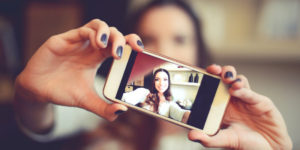For travel brands hoping to retain a leg up, understanding the importance of visual appeal in selling travel services is essential. Selfies have not only revolutionized the vacation experience, but they have inspired an entire generation of would-be travelers to get out and see the world. While critics have launched an all-out assault against subscribers to the growing selfie addiction, the impact of this phenomenon has been unstoppable.
Here are four ways selfies have changed the travel industry indefinitely.
1. People Plan Destinations with Social Media in Mind
A traveler aims her smartphone, smiles into the lens, and shoots. Minutes later, she’s uploaded a head shot brandishing rows of breathtaking snow caps towering in the backdrop.
This new obsession has not only given people new reason to travel, but it has also inspired social media lovers to document play-by-play accounts along the way.
Research shows an astounding 70-percent of travelers perform status updates during vacation while nearly 50-percent check into locations on Facebook. In fact, several people have admitted to choosing destinations they hope might generate interest in the form of “likes” and “shares.”
2. Travel Agencies Use Selfies to Develop Marketing Strategies
Travel companies across the globe are stepping up to meet the demands of hundreds of millions of social media users. U.S. companies alone spend billions per year on digital advertising (with mega companies like Expedia leading the way), hoping to influence the consumer decision-making process.
Similar to many other industries, selfies have afforded these agencies the opportunity to develop emotional connections to consumers. And with nearly 70-percent of internet users active on social media, companies are wise to take uploaded images into account when drafting marketing strategies.
3. Companies are Influenced by Customer Reviews
Since the start of the selfie craze, advertising practices have been continuously evolving. For starters, companies are driven by a greater sense of accountability. With customers reporting play-by-play during vacations, followers can expect instantaneous reactions to travel services.
A spokesperson for TopView NYC, a sightseeing company out of New York City, says, “Happy customers taking selfies with their smartphones are one of our biggest marketing assets. Never underestimate the value of user generated content.”
It’s no surprise that user-generated content accounts for much of the data employed when shaping online marketing trends. Selfie-directed Instagram posts are essentially leading the way to a smoother travel experience.
4. Companies Can Target Consumers Directly
Millennials, particularly those in their early to mid-20s, are traveling more, and companies are shoveling out coupons promising cheaper hotels and competitive group rates. Selfies actually allow travel agents to alleviate much of the speculative work and, in turn, create personalized marketing campaigns. As intrusive as these tactics may seem, consumers still benefit in the end, having transformed the way companies solicit their business. Ultimately, agencies are compelled to work diligently to provide competitive services.








